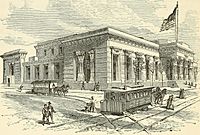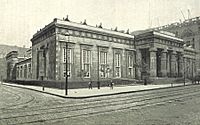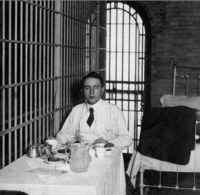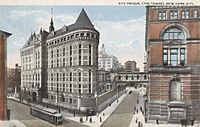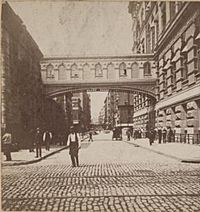The Tombs facts for kids
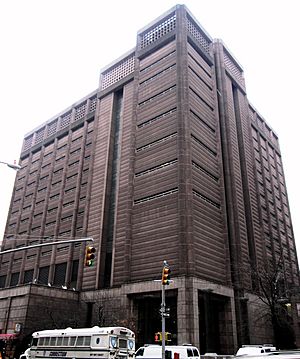 |
|
| Location | New York City, United States |
|---|---|
| Status | Active |
| Security class | Municipal Jail |
| Opened | 1838 (original building) |
| Former name | Halls of Justice, Manhattan House of Detention |
| Managed by | New York City Department of Corrections |
| Director | Commissioner Joseph Ponte |
The Tombs is a popular nickname for the Manhattan Detention Complex. It is a jail located in Lower Manhattan, New York City. The name "The Tombs" has also been used for three older jails that stood in the same area. This area was once known as Five Points and is now called the Civic Center.
The very first jail known as The Tombs was officially called the Halls of Justice. It was built in 1838. Its design was inspired by ancient Egyptian buildings. This new jail replaced an older one from the 1700s called Bridewell Prison. Parts of the old Bridewell Prison were used to build the new Tombs to save money.
Over time, four different buildings have been known as The Tombs:
- 1838–1902: New York City Halls of Justice and House of Detention
- 1902–1941: City Prison
- 1941–1974: Manhattan House of Detention
- 1983–present: Manhattan Detention Complex (also known as the Bernard B. Kerik Complex from 2001 to 2006)
Contents
History of The Tombs Jails
The First Tombs: 1838–1902
The first building to be called The Tombs was designed by John Haviland. It was finished in 1838. This building was very large, covering a whole city block. It could hold about 300 prisoners.
The land where the jail was built used to be a large pond called the Collect Pond. This pond was once a main water source for New York City. But by the late 1700s, it became very polluted. So, the pond was drained and filled in by 1817. However, the ground was not filled properly. It started to sink less than 10 years later. This created a swampy, smelly area that became a poor neighborhood called Five Points.
The heavy jail building was built on top of wooden piles to make it stable. But the whole structure still began to sink soon after it opened. This damp foundation led to very unhealthy conditions inside the prison for many years.
The official name for this jail was The New York Halls of Justice and House of Detention. It held the city's courts, police, and jail facilities. The building was known for its Egyptian Revival architecture. Some people liked its unique look, while others did not.
The prison had many problems, including escapes. A fire damaged part of the building in 1842. A famous politician named William J. Sharkey escaped from the prison in 1872. He dressed up as a woman and was never caught.
Rebecca Salome Foster was a relief worker who helped prisoners. She was known as "the Tombs Angel." She worked to help the many poor people held in the jail's bad conditions. A monument was built for her in 1902. It was moved in 1940 and then put back on display in 2019.
The Second Tombs: 1902–1941
In 1902, the old 1838 building was replaced. The new building was called the City Prison. It cost a million dollars to build. It had an eight-story front designed in the Châteauesque style, with pointed towers.
This new prison was connected to the Manhattan Criminal Courts Building by a "Bridge of Sighs." This bridge crossed four stories above Franklin Street. There was also an extra building with 144 more cells that had been finished in 1884.
The Third Tombs: 1941–1974
The 1902 prison was replaced again in 1941. This new building was a tall facility designed in the Art Deco style. It was designed by architects Harvey Wiley Corbett and Charles B. Meyers.
This building is the northernmost of four tall towers. These towers make up the New York City Criminal Courts Building at 100 Centre Street. The other three towers hold the city's courts and offices. The northern tower is separate and has its own address: 125 White Street. It was officially called the Manhattan House of Detention for Men (MHD). But people still called it The Tombs.
By 1969, this Tombs jail was considered the worst of the city's jails. It was very crowded and had poor conditions. It held about 2,000 inmates, but it was only built for 925. In 1970, inmates protested the bad conditions. They took control of one floor and held five officers hostage for several hours.
After years of legal battles, a judge decided that the prison's conditions were so bad they were against the law. So, the city decided to close The Tombs on December 20, 1974. The remaining 400 inmates were moved to Rikers Island.
The Current Tombs: 1983–Present
Today, the Manhattan Detention Complex has two parts. There is a South Tower, which is the old Manhattan House of Detention that was updated and reopened in 1983. There is also a North Tower across White Street, which was finished in 1990.
The complex still holds only male inmates. Most of them are waiting for their trials. Together, the two buildings can hold almost 900 people. In late 2020, there were plans to close the complex.
The current jail was named The Bernard B. Kerik Complex in 2001. This was done by New York City mayor Rudolph Giuliani. Kerik was in charge of the New York City Department of Corrections before becoming police commissioner. Later, Mayor Michael Bloomberg ordered Kerik's name removed from the building. This happened after Kerik admitted to some legal issues from his time as a city employee in 2006.
Images for kids
See also
 In Spanish: The Tombs para niños
In Spanish: The Tombs para niños


